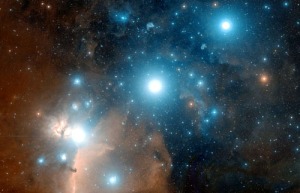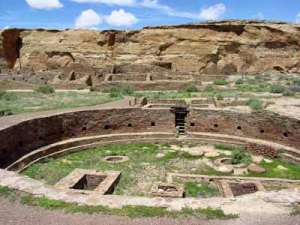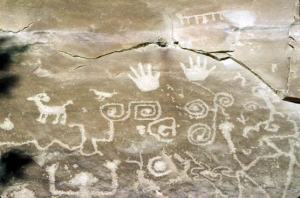 Like in myriad other ancient cultures, Native American Hopi mythology – and even their landscape – focus on Orion. Hopi mesas are laid out in the same pattern as the stars in Orion’s Belt and, since the Hopi moved frequently until finally settling down, it appears they may have chosen the location specifically due to this natural pattern and believed it to be a place from which they could contact the gods. In fact, every major star in the Orion constellation corresponds with Hopi ruins or existing villages.
Like in myriad other ancient cultures, Native American Hopi mythology – and even their landscape – focus on Orion. Hopi mesas are laid out in the same pattern as the stars in Orion’s Belt and, since the Hopi moved frequently until finally settling down, it appears they may have chosen the location specifically due to this natural pattern and believed it to be a place from which they could contact the gods. In fact, every major star in the Orion constellation corresponds with Hopi ruins or existing villages.
For example, Orion’s right shoulder corresponds with the Hopi ruin Homolovi, and his left shoulder with the Hopi ruin Wupatki. North of the mesas are more ruins that correspond with Rigel, the brightest star in the constellation.
 Most Ancient Hopi settlements were built into steep cliffs – far from ideal locations. Archaeologists believe that the cliffs were preferred for their strong defensive position, but this doesn’t seem like enough to make it worth the disadvantages, especially in winter. Hovenweep National Monument is one such site, whose towers are thought to have been used as astronomical observatories – this makes sense, since Hopi legends say the ancestors were guided by the stars. Another Ancient Hopi site, Chaco Canyon, has intricate astronomical alignments incorporated into its design. Further evidence of astrological knowledge can be seen in the site’s spiral petroglyph, which was used to mark off equinoxes and solstices.
Most Ancient Hopi settlements were built into steep cliffs – far from ideal locations. Archaeologists believe that the cliffs were preferred for their strong defensive position, but this doesn’t seem like enough to make it worth the disadvantages, especially in winter. Hovenweep National Monument is one such site, whose towers are thought to have been used as astronomical observatories – this makes sense, since Hopi legends say the ancestors were guided by the stars. Another Ancient Hopi site, Chaco Canyon, has intricate astronomical alignments incorporated into its design. Further evidence of astrological knowledge can be seen in the site’s spiral petroglyph, which was used to mark off equinoxes and solstices.
 The Hopi believed their ancestors came into this world through a crack in a place called Sipapu, which is situated near Desert View and is a natural salt dome with a mineral hot spring. According to legend, when the Hopi entered the Fourth World, the caretaker of the land (previously the god of the dead), Maasaw (or Masau’u), greeted them and told them to separate into clans and migrate across the land. Guided by the stars and a sacred tablet that Maasaw gave them, the Hopi clans would eventually come together again and settle down. Maasaw allegedly also gave each clan a magical water jar, with the knowledge of how to make another if it broke. Some modern Hopi believe that these water jars could explain why regions seemed to dry up around the time a Hopi clan left, explaining that the jar created rivers, enabling the clans to live anywhere, including previously dry regions. Historians theorise that the Hopi left each settlement due to severe drought, but, if the modern Hopi theory is right, the areas dried up because the Hopi left. Hopi mythology further tells us that each clan was instructed to migrate four times, but not all of them did – only those who believed the migrations were purifying them completed all four. The Hopi mesas are said to be the final settlement where the ‘purified’ clans finally came together. The town on the third mesa is the oldest Northern American town and has been inhabited continuously since it was built.
The Hopi believed their ancestors came into this world through a crack in a place called Sipapu, which is situated near Desert View and is a natural salt dome with a mineral hot spring. According to legend, when the Hopi entered the Fourth World, the caretaker of the land (previously the god of the dead), Maasaw (or Masau’u), greeted them and told them to separate into clans and migrate across the land. Guided by the stars and a sacred tablet that Maasaw gave them, the Hopi clans would eventually come together again and settle down. Maasaw allegedly also gave each clan a magical water jar, with the knowledge of how to make another if it broke. Some modern Hopi believe that these water jars could explain why regions seemed to dry up around the time a Hopi clan left, explaining that the jar created rivers, enabling the clans to live anywhere, including previously dry regions. Historians theorise that the Hopi left each settlement due to severe drought, but, if the modern Hopi theory is right, the areas dried up because the Hopi left. Hopi mythology further tells us that each clan was instructed to migrate four times, but not all of them did – only those who believed the migrations were purifying them completed all four. The Hopi mesas are said to be the final settlement where the ‘purified’ clans finally came together. The town on the third mesa is the oldest Northern American town and has been inhabited continuously since it was built.
While some modern Hopi have been happy to talk to journalists, the people are still largely a mystery, with much of their festivals closed to outsiders and no photographs allowed. The Hopi take their privacy seriously, and modern-day ceremonial buildings, churches and gravesites are out of bounds.
Were the Ancient Hopi truly instructed by the gods? If so, were these gods perhaps extraterrestrials? It would certainly explain where the Hopi got their knowledge of astronomy, for one. What do you think?









Reblogged this on Die Goldene Landschaft.
LikeLike